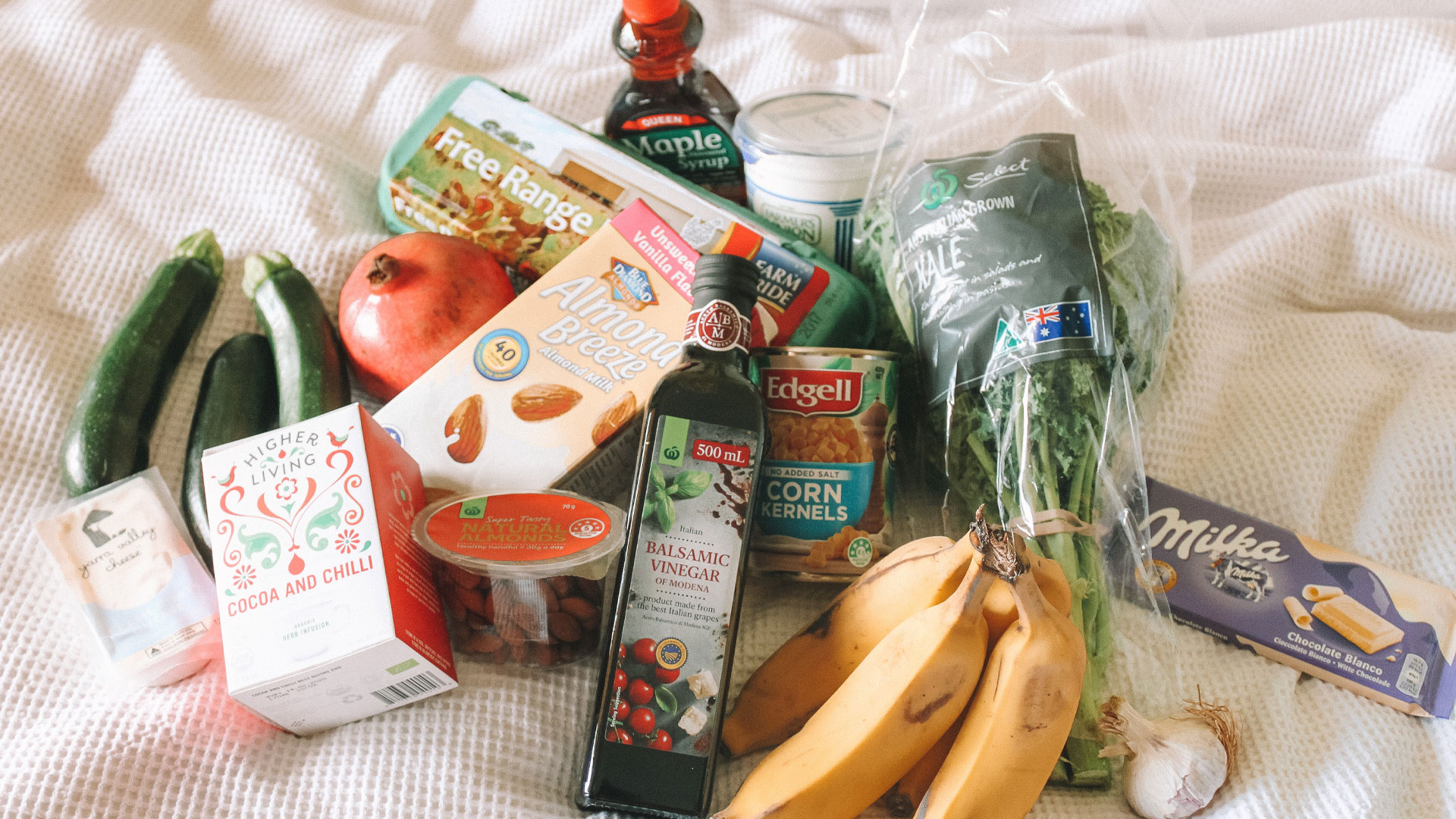Are you looking to change the way you shop for food? Then learning why it’s important to start reading the nutrition label is a significant first step! Although looking at the nutritional facts can seem overwhelming (and, let’s be honest… confusing!), this blog post will break down and explain what you need to know when it comes to reading food labels.
Once you learn why it’s important to start reading the nutrition label, you’ll be able to shop faster and make healthier informed choices.

This post may contain affiliate links. Please read my disclaimer.
What Are Nutrition Labels?
Food labels (also known as nutrition facts labels) list the approximate percentages of each nutrient based on a daily diet of 2,000 calories in the United States.
Generally, using food labels can help guide you on what to buy as part of an overall healthy meal plan.
Why Should You Be Reading the Nutrition Label?
Learning how to read food labels is an important life skill for everyone. Doing this will make it much easier for you and your family to make the best, healthy choices when doing your grocery shopping.
Because food labels tell us exactly how much of each nutrient is in each serving, you will (with practice) be able to make quick and healthy decisions without feeling overwhelmed or stressed by all of the endless options.
Why You Should Be Reading the Nutrition Label (And How to Do It!

Serving Size
The very first thing you should look at is the serving size.
The food label is based on the indicated serving size. Above the serving size will tell you how many servings are in each container.
Remember that the indicated serving size may not always reflect how much you’re actually eating.
For example, a packet of instant noodles may contain 2 servings per container.
Let’s say one serving is equal to 190 calories. So eating the entire packet of instant noodles in one sitting would result in twice the calories and other nutrients listed on the label.
So, 190 calories per serving multiplied by 2 servings per container would equal 380 calories.
Instead of using the serving size number to determine how much you should eat, you should use it to determine how many calories you are consuming in a single serving.
The number of servings you’ll need will come down to your personal goals (i.e., maintain weight, gain weight, or lose weight).
Calories
Next, you’ll want to pay attention to the number of calories per serving. Calories refer to how much energy you get from a single food serving. Looking at this can also help you manage your weight goals.
On food labels, you may or may not see calories from fat. However, if you see one, this will indicate how many calories in a single serving comes from fat.
Remember that the number of servings you consume will determine the number of calories you actually eat.
- Overeat, and you risk gaining weight.
- Eat too little, and you risk losing weight.

Here is a general guideline to follow when deciding what is too little or too much*
- 40 calories or less is generally considered low
- 100 calories or less is generally considered moderate
- 400 calories or less is generally considered high
*This guide is based on a 2,000-calorie diet per day.

Percent Daily Value
On the right-hand side of the food label, you’ll see the percent daily value (%DV) displayed in percentages. This number tells you how much a particular nutrient in a single serving of food contributes to your total daily diet based on a recommended 2,000-calorie per day diet.
This is a helpful guideline to show you if the food is low or high in nutrients.
In general:
- 5% or less of daily value is considered low in that nutrient
- 20% or more of daily value is considered high in that nutrient
Total Fat
Next on the list is total fat. There are typically two types of fat to look out for:
- Saturated fat
- Trans fat
According to new research, we’re learning that moderate intakes of saturated fat can raise HDL levels (good cholesterol) and change LDL (bad cholesterol) from small and dense to mostly benign, which is associated with a reduced risk of heart disease.
If you struggle with certain medical conditions, it’s recommended that you still watch your saturated fat intake.
Trans fat is the worst kind of fat you can find on a label. Also known as trans fatty acids, trans fat raises your LDL (bad cholesterol) and lowers your HDL (good cholesterol).
Unfortunately, suppose a food has less than 0.5 grams of trans fat in a serving. In that case, a US food manufacturer can indicate 0 grams of trans fat on the food label.
Here’s what you can do about this:
- Check the ingredient list.
- Look for partially hydrogenated vegetable oil, which means that the food contains some trans fat.
Cholesterol
Cholesterol is a waxy, fat-like substance produced primarily by the liver.
There are two types of cholesterol found in the bloodstream: HDL and LDL.
- HDL (high-density lipoprotein) absorbs cholesterol and helps prevent buildup in your bloodstream by traveling back to the liver.
- LDL (low-density lipoprotein) makes up most of your body’s cholesterol and is the leading cause of buildup in your arteries.
Here is a general guideline to follow when reading food labels for cholesterol:
- 5% or less of daily value is considered low
- 20% or more of daily value is considered high
- Cholesterol is found in animal-based foods, like meats and dairy products
Sodium
Sodium is a mineral and one of the chemical elements found in salt. Whereas salt (also known by its chemical name, sodium chloride) is a crystal-like compound found in nature.
Your body only needs a small amount of sodium to function properly.
Here is a general guideline to follow when reading food labels for sodium:
- 5% or less of the daily value per serving is considered low
- 20% or more of the daily value per serving is considered high
Total Carbohydrates
Carbohydrates break down into glucose during digestion, which can be used as energy. It can also be turned into fat for stored energy for later use.
The number of carbohydrates shown on food labels includes starches, complex carbohydrates, dietary fiber, added sugars, and non-digestible additives.
Dietary Fiber
Dietary fiber is indigestible and usually passes through your intestinal tract without being absorbed.
It’s recommended that you get at least 25 grams of dietary fiber per day. Foods high in fiber usually will contain at least 5 grams per serving. Great sources of fiber include fruits, vegetables, and whole grains.
Sugars
Sugars give you the total carbohydrate, in grams, from naturally occurring sugars like lactose (milk sugar) and fructose (fruit sugar) PLUS any added sugars like high fructose corn syrup, brown and white sugar, cane juice, etc.
Added sugars are the sugars and syrups added to foods during processing or preparation. They add calories but little to no nutrients.
Protein
Protein is one of the three macronutrients that provide energy for your body and can be found in animals and plants. Your body uses protein to build and repair cells and make enzymes, hormones, and other body chemicals.
As mentioned earlier, protein is one of the three macronutrients (alongside fats and carbohydrates), which means your body needs a lot to function optimally!
Here Are Healthy Sources of Protein
- Beans and legumes
- Grass-fed beef and pasture-raised meats and dairy products
- Pasture-raised eggs
- Nuts and seeds
- Non-GMO soy (i.e., tofu)
- Seafood
- Whole grains and vegetables
You might like:
- 5 Anti-Inflammatory List of Foods You Can Start Eating Today
- What’s the Difference Between Yams and Sweet Potato?
Vitamins & Minerals
Vitamins and minerals are essential micronutrients that your body needs.
They’re essential because they aid in healing wounds, repairing damaged cells, boosting the immune system, and converting food into energy.
But, because they’re micro, you only need tiny amounts of them instead of macronutrients where you need a lot! Your best bet for getting all the vitamins and minerals you need is to eat a wide variety of healthy foods (i.e. eat the rainbow).
Ingredient List
The ingredient list is the section I pay the most attention to. Each ingredient is listed in descending order by weight with the most listed first and the least listed last.
Taking Action
Knowing how to read food labels is an important life skill to learn to make healthy, informed food choices.
For most people, reading food labels can be overwhelming and confusing. Often, you don’t know what to look for and what to avoid.
By teaching yourself this necessary skill, you and your family will be able to make quick and healthy decisions on your next grocery trip.
Did you find this post helpful? Please leave a comment and let me know! I’d love to hear from you.
Disclaimer: This content is meant for informational and educational purposes, only. It is not intended to provide medical advice or take the place of such advice from a personal physician. Please consult with your doctor regarding specific health and lifestyle questions and concerns.

